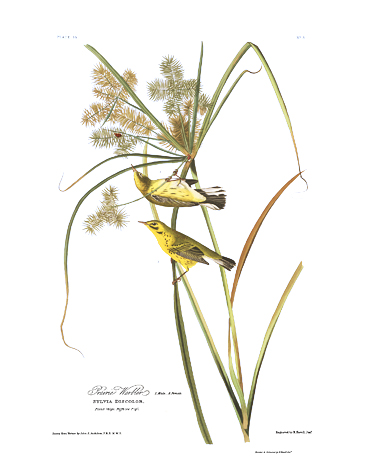|
Havell Name
Prairie Warbler Common Name Prairie Warbler Havell Plate No. 014 Paper Size 39" x 28" Image Size 17" x 11" Price $ 800 |
||||
|
Ornithological Biography This little bird has no song, at least I never heard any from it, excepting a delicate soft whirr, ejaculated whilst it stands erect on the top of some rank weed or low bush. Its nest, which forms by far the most interesting part of its history, is uncommonly small and delicate. Its eggs I have uniformly found to be four in number, and of a white colour, with a few brownish spots near the larger end. The nest is sometimes attached to three or four blades of tall grass, or hangs between two small sprigs of a slender twig. At first sight, it seems to be formed like that of the Humming-bird, the external parts being composed of delicate grey lichens and other substances, and skins of black caterpillars, and the interior finished with the finest fibres of dried vines. Two broods are reared each season.
In Louisiana I found this bird amongst our cotton fields, where it easily procures the small insects and flies of which its food is entirely composed. It is also found in the prairies along the skirts of the woodlands. I have shot several within a few miles of Philadelphia, in the Jerseys, in a large opening where the woods had been cut down, and were beginning to spring up again. Its flight is light and short, it making an effort to rise to the height of eight or ten yards, and immediately sinking down to the grass or bushes. Whilst on the ground, where it remains a good deal, it searches amongst the leaves slowly and carefully, differing in this respect from all the true Warblers with which I am acquainted. They go singly, and far apart, scarcely more than three or four being ever seen on an extent of twenty or thirty acres. It is one of the first birds that arrives in spring in Louisiana, and one of the first to depart, being rarely found after the first week of September. I never saw it farther east than on the ridges of the Broad Mountain, about twelve miles from Mauch Chunk; but I have seen it on the Arkansas river, and high up on the Mississippi, as well as along the southern borders of Lake Erie. The young are apt to leave the nest if discovered when unable to fly, and follow their parents through the grass to be fed. The plant on which a pair of Prairie Warblers are represented, is commonly called buffalo grass, and is found all along the edges of our extensive prairies, in the barrens of Kentucky, and in Louisiana, excepting in the swamps, it being more inclined to grow in dry soil and stiff grounds. |
|||||
|
|
|||||


| Home | Gallery | Audubon Biography | About Edition | Testimonials | Authorized Dealers | Links | Contact Us |

© Copyright 2007-2025 Zebra Publishing, LLC. | All Rights Reserved Terms of Use
Powered by Fusedog Media Group
